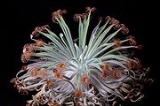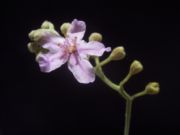
Drosera ordensis
Encyclopedia
Drosera ordensis is a species
of sundew
, native to Australia
and part of the "petiolaris complex" of sundews making up the subgenus
Lasiocephala
. Compared to many petiolaris sundews, it has wide petioles
, which are densely covered in silvery hairs. It usually forms rosettes
8 cm across, although plants up to 20 cm in diameter have been reported.
 A perennial
A perennial
rosette
-forming herb
, D. ordensis forms clumps of stemless or nearly stemless rosettes. Each plant has numerous leaves, which as typical for the subgenus consist of a long, hairy petiole supporting a nearly round lamina
. The lamina is densely studded with stalked mucilage
nous glands, which serve to attract and trap arthropod
prey, which is subsequently digested and absorbed by the plant as a source of nutrients. During the dry season, the plant produces smaller, somewhat dormant leaves which are protected by their dense covering of silvery hairs.
Drosera ordensis flowers from December through April. Flowers form on a crowded raceme
, opening singly. The five-petaled flowers can be pink to nearly white and are about 1.5 cm in diameter.
near Kununurra and Pago
and in the neighbouring region of the Northern Territory
in Keep River National Park
. The plant is often associated with Sorghum
species.
Species
In biology, a species is one of the basic units of biological classification and a taxonomic rank. A species is often defined as a group of organisms capable of interbreeding and producing fertile offspring. While in many cases this definition is adequate, more precise or differing measures are...
of sundew
Sundew
Drosera, commonly known as the sundews, comprise one of the largest genera of carnivorous plants, with at least 194 species. These members of the family Droseraceae lure, capture, and digest insects using stalked mucilaginous glands covering their leaf surface. The insects are used to supplement...
, native to Australia
Australia
Australia , officially the Commonwealth of Australia, is a country in the Southern Hemisphere comprising the mainland of the Australian continent, the island of Tasmania, and numerous smaller islands in the Indian and Pacific Oceans. It is the world's sixth-largest country by total area...
and part of the "petiolaris complex" of sundews making up the subgenus
Subgenus
In biology, a subgenus is a taxonomic rank directly below genus.In zoology, a subgeneric name can be used independently or included in a species name, in parentheses, placed between the generic name and the specific epithet: e.g. the Tiger Cowry of the Indo-Pacific, Cypraea tigris Linnaeus, which...
Lasiocephala
Drosera subg. Lasiocephala
Drosera subg. Lasiocephala, sometimes collectively known as the petiolaris-complex, is a subgenus of 14 species in the genus Drosera. These species are distinguished by their subpeltate to peltate lamina....
. Compared to many petiolaris sundews, it has wide petioles
Petiole (botany)
In botany, the petiole is the stalk attaching the leaf blade to the stem. The petiole usually has the same internal structure as the stem. Outgrowths appearing on each side of the petiole are called stipules. Leaves lacking a petiole are called sessile, or clasping when they partly surround the...
, which are densely covered in silvery hairs. It usually forms rosettes
Rosette (botany)
In botany, a rosette is a circular arrangement of leaves, with all the leaves at a single height.Though rosettes usually sit near the soil, their structure is an example of a modified stem.-Function:...
8 cm across, although plants up to 20 cm in diameter have been reported.
Description

Perennial plant
A perennial plant or simply perennial is a plant that lives for more than two years. The term is often used to differentiate a plant from shorter lived annuals and biennials. The term is sometimes misused by commercial gardeners or horticulturalists to describe only herbaceous perennials...
rosette
Rosette (botany)
In botany, a rosette is a circular arrangement of leaves, with all the leaves at a single height.Though rosettes usually sit near the soil, their structure is an example of a modified stem.-Function:...
-forming herb
Herbaceous plant
A herbaceous plant is a plant that has leaves and stems that die down at the end of the growing season to the soil level. They have no persistent woody stem above ground...
, D. ordensis forms clumps of stemless or nearly stemless rosettes. Each plant has numerous leaves, which as typical for the subgenus consist of a long, hairy petiole supporting a nearly round lamina
Leaf
A leaf is an organ of a vascular plant, as defined in botanical terms, and in particular in plant morphology. Foliage is a mass noun that refers to leaves as a feature of plants....
. The lamina is densely studded with stalked mucilage
Mucilage
Mucilage is a thick, gluey substance produced by most plants and some microorganisms. It is a polar glycoprotein and an exopolysaccharide.It occurs in various parts of nearly all classes of plant, usually in relatively small percentages, and is frequently associated with other substances, such as...
nous glands, which serve to attract and trap arthropod
Arthropod
An arthropod is an invertebrate animal having an exoskeleton , a segmented body, and jointed appendages. Arthropods are members of the phylum Arthropoda , and include the insects, arachnids, crustaceans, and others...
prey, which is subsequently digested and absorbed by the plant as a source of nutrients. During the dry season, the plant produces smaller, somewhat dormant leaves which are protected by their dense covering of silvery hairs.
Drosera ordensis flowers from December through April. Flowers form on a crowded raceme
Raceme
A raceme is a type of inflorescence that is unbranched and indeterminate and bears pedicellate flowers — flowers having short floral stalks called pedicels — along the axis. In botany, axis means a shoot, in this case one bearing the flowers. In a raceme, the oldest flowers are borne...
, opening singly. The five-petaled flowers can be pink to nearly white and are about 1.5 cm in diameter.
Distribution and habitat
Drosera ordensis inhabits sandy soils near sandstone outcrops in the northeaster tip of Western AustraliaWestern Australia
Western Australia is a state of Australia, occupying the entire western third of the Australian continent. It is bounded by the Indian Ocean to the north and west, the Great Australian Bight and Indian Ocean to the south, the Northern Territory to the north-east and South Australia to the south-east...
near Kununurra and Pago
Pago
Pago may refer to:* Chalan Pago-Ordot, Guam, a municipality** Pago Bay, on the coast of Guam* pago, the Chamorro word for Hibiscus tiliaceus* Pago Pago, American Samoa* the Italian name for Pag , off the coast of Croatia...
and in the neighbouring region of the Northern Territory
Northern Territory
The Northern Territory is a federal territory of Australia, occupying much of the centre of the mainland continent, as well as the central northern regions...
in Keep River National Park
Keep River National Park
Keep River National Park is in the Northern Territory of Australia, 418 km southwest of Darwin and 468 km west of Katherine. The nearest town is Kununurra in Western Australia.-Environment:...
. The plant is often associated with Sorghum
Sorghum
Sorghum is a genus of numerous species of grasses, one of which is raised for grain and many of which are used as fodder plants either cultivated or as part of pasture. The plants are cultivated in warmer climates worldwide. Species are native to tropical and subtropical regions of all continents...
species.
See also
- List of Drosera species
- Taxonomy of Drosera

